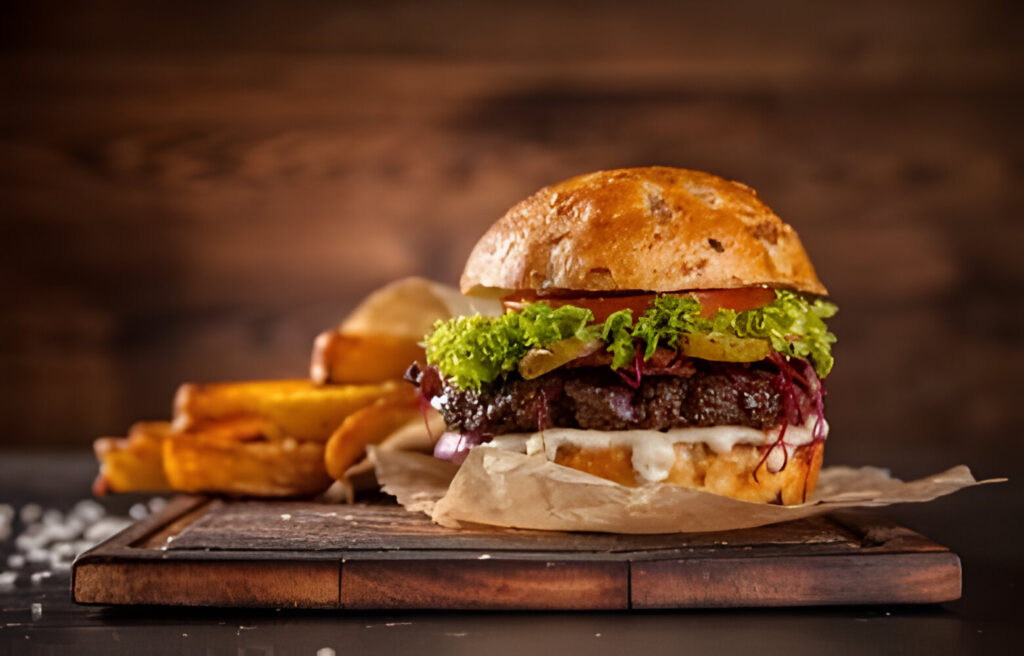
Introduction to Hamburger Steak
The Origins and Journey
The hamburger steak holds a unique place in culinary history, tracing its roots back to the 19th century. Originating from Germany, specifically the city of Hamburg, it quickly found its way across the ocean to the United States, where it evolved. The American adaptation embraced a more straightforward approach, focusing on ground beef and simple seasonings. This evolution underscores the dish’s versatility and its ability to blend into various cultures. Today, the hamburger steak stands as a testament to cross-cultural culinary exchange, loved by many for its heartiness and comforting flavors.
A Dish of Many Virtues
Beyond its rich history, the hamburger steak shines for its adaptability. Chefs and home cooks alike celebrate it for its straightforward preparation, using ingredients that are often at hand. Its simplicity does not detract from its appeal; rather, it allows for creativity in seasonings, cooking methods, and presentations. Whether grilled, pan-fried, or broiled, each method unlocks distinct flavors and textures, making every hamburger steak experience unique.
Moreover, the hamburger steak’s popularity transcends borders, featuring in diners, upscale restaurants, and home kitchens worldwide. This universality speaks to its enduring appeal and the shared joy of a well-made, comforting meal. Its ability to adapt to dietary preferences and restrictions further elevates its status in the culinary world, making it a dish for everyone to enjoy.
Our Culinary Expedition
This article embarks on a culinary expedition, aiming to explore the depths of the hamburger steak’s potential. From its humble beginnings to the countless variations adorning menus today, we delve into the essence of what makes this dish a beloved classic. Along the way, we’ll uncover the secrets to perfecting the hamburger steak, exploring ingredient choices, cooking techniques, and serving suggestions to enhance your dining experience. Join us as we celebrate this culinary marvel, offering insights and inspiration for both seasoned cooks and culinary novices alike.
Ingredients and Substitutes
Essential Ingredients for a Classic Hamburger Steak
Creating a flavorful hamburger steak begins with a foundation of key ingredients. Ground beef, preferably with a fat content of about 15-20%, forms the base, providing juiciness and flavor. To enhance the meat, finely chopped onions, minced garlic, and a blend of salt and pepper are essential. For binding and moisture, eggs and breadcrumbs come into play, ensuring the steak holds its shape while cooking. Finally, a touch of Worcestershire sauce adds depth, completing the profile of a classic hamburger steak.
Incorporating these ingredients, one can craft a hamburger steak that’s not only traditional but also rich in taste. Each component plays a critical role, from the ground beef’s texture to the seasoning’s flavor enhancement. As we explore these essentials, remember that quality matters. Opting for fresh, high-quality ingredients will significantly impact the dish’s final taste and texture.
Creative Substitutes for Dietary Needs
Catering to dietary restrictions doesn’t mean sacrificing flavor or enjoyment. For those avoiding red meat, ground turkey or chicken serves as a light yet satisfying alternative. Vegetarians can embrace lentils or chickpeas mixed with mushrooms for a hearty, meat-free patty. Gluten-free breadcrumbs or rolled oats can replace traditional breadcrumbs for those with gluten sensitivities. Similarly, a flaxseed or chia seed mixture can stand in for eggs, ensuring the patty remains cohesive during cooking.
These substitutes not only ensure the hamburger steak remains accessible to all but also introduce new textures and flavors. Experimenting with these alternatives can lead to delightful discoveries, enriching the culinary experience. Moreover, such modifications demonstrate the hamburger steak’s versatility, proving it’s a dish limited only by one’s imagination.
Quality and Selection Tips
Selecting the right ingredients is pivotal for a memorable hamburger steak. For the ground beef, aim for fresh, high-quality meat from a trusted butcher or grocer. The fat content, as mentioned, should hover around 15-20%, striking a balance between flavor and juiciness. When it comes to onions and garlic, fresher is always better, offering a more potent aroma and taste. For breadcrumbs, consider the dish’s overall flavor profile—plain breadcrumbs offer versatility, while seasoned ones can add an extra flavor dimension.
These tips not only guide you in making informed ingredient choices but also in elevating the dish’s overall quality. The attention to detail in selecting ingredients reflects in the depth of flavor and texture in the finished hamburger steak. As such, taking the time to choose the best possible components is a step toward culinary excellence.
By focusing on quality ingredients and adaptable substitutes, this section lays the foundation for a hamburger steak that’s both classic and inclusive. Through thoughtful selection and creativity, the dish becomes a canvas for personal expression, catering to a wide range of tastes and dietary preferences.
Step-by-Step Cooking Guide
Preparing Your Ingredients
Before diving into the cooking process, organizing and preparing your ingredients ensures a smooth and efficient experience. Start by finely chopping the onions and mincing the garlic, as these will be mixed into the ground beef for flavor. Next, in a large bowl, combine the ground beef with the onions, garlic, salt, pepper, and Worcestershire sauce. Add in the beaten egg and breadcrumbs, which will help bind the mixture together. Mix well until the ingredients are evenly distributed, but avoid overmixing to keep the meat tender.
This initial preparation sets the stage for a delicious hamburger steak, highlighting the importance of ingredient quality and mix uniformity. As you blend these elements, consider the textures and flavors you’re combining, ensuring they complement each other well.
Cooking Your Hamburger Steak to Perfection
Once your mixture is ready, divide it into equal portions, shaping each into a steak-like patty. Heat a skillet or frying pan over medium-high heat, adding a small amount of oil once hot. Carefully place the patties in the pan, cooking them for about 4-5 minutes on each side, or until they reach a golden-brown crust and are cooked to your desired level of doneness.
During this process, resist the urge to press down on the patties, as this can release their juices, leading to a drier steak. Instead, let them cook undisturbed, which allows for a better sear and juicier result. Once cooked, remove the patties from the pan and let them rest for a few minutes. This resting period lets the juices redistribute, ensuring a moist and flavorful steak.
Visuals and Tips for a Flawless Dish
Achieving the perfect hamburger steak involves not just following steps but also understanding the nuances of cooking. Keep an eye on the heat level; if the pan gets too hot, the steaks may burn on the outside while remaining undercooked inside. Adjust the heat as necessary to ensure even cooking.
For an extra touch of flavor, consider deglazing the pan with a bit of beef broth or red wine after cooking the steaks. This step allows you to scrape up the flavorful bits left in the pan, creating a simple yet delicious sauce to drizzle over the steaks.
Remember, cooking is as much about intuition as it is about technique. Trust your senses—sight, smell, and touch—to guide you to the perfect hamburger steak. With practice and attention to detail, you’ll master the art of cooking this classic dish, ready to impress with its simplicity and depth of flavor.

Nutritional Information and Health Benefits
Breaking Down the Nutritional Content
A well-prepared hamburger steak is more than a delight to the taste buds; it’s also a source of valuable nutrients. At its core, the dish provides a significant amount of protein, essential for muscle repair and growth. The ground beef, the main ingredient, is also rich in iron, which plays a crucial role in oxygen transport and energy production in the body. Furthermore, by incorporating onions and garlic into the mix, you add not only flavor but also vitamins C and B6, alongside antioxidants that support immune function and overall health.
When considering the nutritional content, it’s important to be mindful of the fat content, particularly if using higher-fat ground beef. Opting for leaner cuts can reduce calorie intake while still providing the benefits of protein and iron. Additionally, incorporating whole grain or gluten-free breadcrumbs can enhance the dish’s fiber content, promoting digestive health.
Health Considerations for a Balanced Diet
Incorporating hamburger steak into a balanced diet requires consideration of portion sizes and the balance of other food groups. Pairing the steak with a side of steamed vegetables or a fresh salad can offset the dish’s richness, adding vitamins and fiber for a more rounded meal. For those monitoring cholesterol or saturated fat intake, choosing lean ground beef and moderating portion sizes are wise strategies to enjoy this dish healthily.
Moreover, the way the hamburger steak is cooked can impact its nutritional profile. Methods like grilling or broiling, which allow excess fat to drip away, can reduce the overall fat content compared to pan-frying in additional oil or butter.
Modifications for Healthier Versions
Creating a healthier version of the hamburger steak is straightforward with a few adjustments. Swapping out the ground beef for a leaner meat like ground turkey or even a plant-based alternative can significantly reduce the dish’s fat content while still providing ample protein. Using egg whites instead of whole eggs can lower the cholesterol content, and opting for whole grain breadcrumbs boosts the dish’s fiber.
These modifications not only make the hamburger steak more suitable for various dietary needs but also allow individuals to experiment with flavors and textures. Ultimately, a focus on fresh, high-quality ingredients, balanced nutrition, and cooking methods that preserve nutritional integrity can make the hamburger steak a worthy addition to any health-conscious diet.
Adapting the classic hamburger steak recipe to fit within a balanced, nutritious diet doesn’t mean sacrificing taste for health. By considering the nutritional content, making smart ingredient choices, and adjusting cooking methods, you can enjoy this beloved dish in a way that supports your well-being.
Serving and Pairing Suggestions
Complementing Side Dishes
A well-prepared hamburger steak, rich and flavorful, calls for side dishes that enhance its taste and add variety to the plate. Mashed potatoes are a classic choice, their creamy texture and buttery flavor melding perfectly with the meaty steak. For a lighter option, consider a vibrant green salad, dressed with a simple vinaigrette, to cut through the richness of the beef. Roasted vegetables, such as carrots, Brussels sprouts, or asparagus, bring a sweet and earthy balance, offering both color and nutrition to your meal.
These sides not only round out the nutritional profile of the meal but also cater to a range of tastes and dietary preferences. Their simplicity allows the hamburger steak to remain the star of the show, while also introducing a variety of textures and flavors to the dining experience.
Wine and Beverage Pairings
Selecting the right beverage to accompany your hamburger steak can elevate the meal from good to gourmet. A full-bodied red wine, like a Cabernet Sauvignon or Merlot, pairs well with the rich flavors of the beef, enhancing its savory notes. For those preferring white wine, a Chardonnay with its buttery undertones can complement the dish nicely.
Non-alcoholic options include a rich, creamy milkshake for a nod to classic diner fare, or a sparkling water with a twist of lemon for a refreshing counterpoint to the meal. These beverages not only complete the dining experience but also cater to individual preferences, ensuring everyone at the table can enjoy a perfectly matched drink.
Presentation Tips
The final touch to serving the perfect hamburger steak lies in its presentation. Arrange the steak alongside your chosen sides on a plate, allowing each component its own space while creating an appealing visual balance. Drizzle any pan sauces over the steak for added flavor and a gourmet touch. Garnishing with a sprig of fresh parsley or a sprinkle of freshly ground black pepper can add color and enhance the dish’s visual appeal.
Presentation plays a crucial role in the dining experience, turning a simple meal into a feast for the senses. By paying attention to these details, you elevate the hamburger steak from a humble dish to a culinary delight, ready to impress and satisfy.
Conclusion: Variations and Creative Twists
Encouraging Experimentation
The journey through crafting the perfect hamburger steak doesn’t end with mastering the basics. This dish’s true beauty lies in its versatility and the endless possibilities for customization. Experiment with different meats, such as lamb or bison, for a unique flavor profile. Incorporate spices like smoked paprika, cumin, or coriander into the meat mixture for an unexpected twist. Even consider mixing in finely chopped vegetables or cheese for added moisture and richness. Each variation not only expands your culinary repertoire but also personalizes the dish to suit your taste or that of your guests.
Embracing experimentation encourages creativity in the kitchen. It transforms cooking from a routine task into a delightful exploration of flavors and textures. So, dare to try new combinations and discover your next favorite version of the hamburger steak.
Sharing and Feedback
One of the joys of cooking is sharing your creations with others. Whether it’s serving a family dinner, hosting friends, or sharing photos and recipes online, each instance offers an opportunity for feedback and connection. Invite others to share their own variations, tips, and experiences. This exchange of ideas fosters a sense of community and can inspire further culinary adventures.
Feedback, whether it’s praise for a dish well done or suggestions for improvement, is invaluable. It provides insights into different tastes and preferences, helping you refine your skills and broaden your culinary horizons.
Final Thoughts
As we wrap up our exploration of the hamburger steak, remember that this dish embodies simplicity, tradition, and versatility. It serves as a reminder that great food doesn’t have to be complicated. With a few quality ingredients and a dash of creativity, you can transform the humble hamburger steak into a gourmet meal.
We encourage you to keep experimenting, sharing, and enjoying the process of cooking. The hamburger steak, with its rich history and adaptability, is more than just a meal; it’s a canvas for culinary expression. So, go ahead, give it your personal touch, and revel in the delicious outcomes of your cooking adventures.

Frequently Asked Questions About Hamburger Steak Recipes
What Makes a Hamburger Steak Different from a Hamburger?
While both dishes use ground beef as their main ingredient, the key difference lies in their presentation and accompaniments. A hamburger steak is typically served without a bun, often accompanied by gravy, onions, and mushrooms. In contrast, a hamburger is served between buns with various toppings like lettuce, tomato, and pickles. The hamburger steak offers a more sit-down meal experience, focusing on the seasoned meat’s flavors, enhanced by its sides and sauces.
Can I Make Hamburger Steak Without Breadcrumbs?
Yes, you can. For those avoiding gluten or simply out of breadcrumbs, there are alternatives. Oats ground into a fine powder, almond flour, or even mashed potatoes can serve as excellent binders. These substitutes not only keep the patties together but also contribute to the dish’s overall flavor and texture, ensuring you can enjoy a delicious hamburger steak regardless of dietary restrictions.
How Do I Know When My Hamburger Steak is Fully Cooked?
The safest way to ensure your hamburger steak is fully cooked is to use a meat thermometer. The internal temperature should reach at least 160°F (71°C) to be considered safe to eat. Visual cues include juices running clear and the meat no longer being pink in the middle. Remember, cooking times may vary based on the thickness of your patties and the heat level, so it’s always best to check with a thermometer.
What are Some Healthy Sides to Serve with Hamburger Steak?
Opting for healthy sides can balance the richness of the hamburger steak. Steamed or roasted vegetables, such as broccoli, carrots, or Brussels sprouts, add color and nutrition without overwhelming the main dish. A side salad with a light vinaigrette or quinoa salad can also offer a refreshing contrast to the savory steak. These sides contribute to a well-rounded meal, ensuring you enjoy both flavor and nutritional benefits.
Can I Prepare Hamburger Steak in Advance?
Absolutely. Preparing the hamburger steak mixture ahead of time can save you valuable minutes during meal preparation. Shape the patties and store them in the refrigerator, covered, for up to a day in advance. When ready to cook, allow them to sit at room temperature for about 10-15 minutes before cooking. This step helps in cooking the steaks more evenly, ensuring a delicious outcome every time.
By addressing these frequently asked questions, we aim to enhance your cooking experience, making it easier and more enjoyable to prepare a delectable hamburger steak. With these tips and tricks, you’re well on your way to mastering this classic dish, ready to impress with its simplicity and hearty flavors.